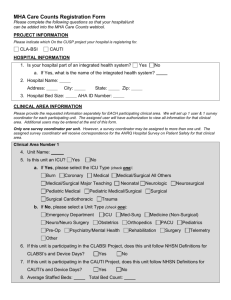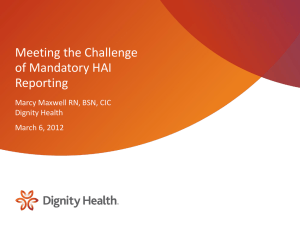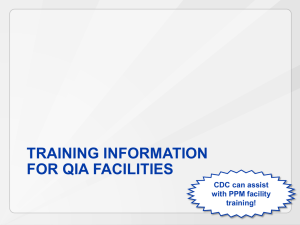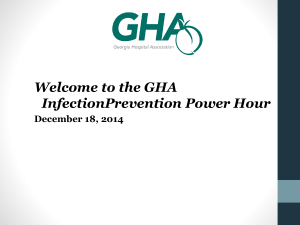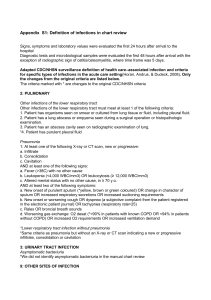Mapping Locations for NHSN Surveillance: Preparing for 2013 9/25/2012 Maggie Dudeck, MPH, CPH
advertisement
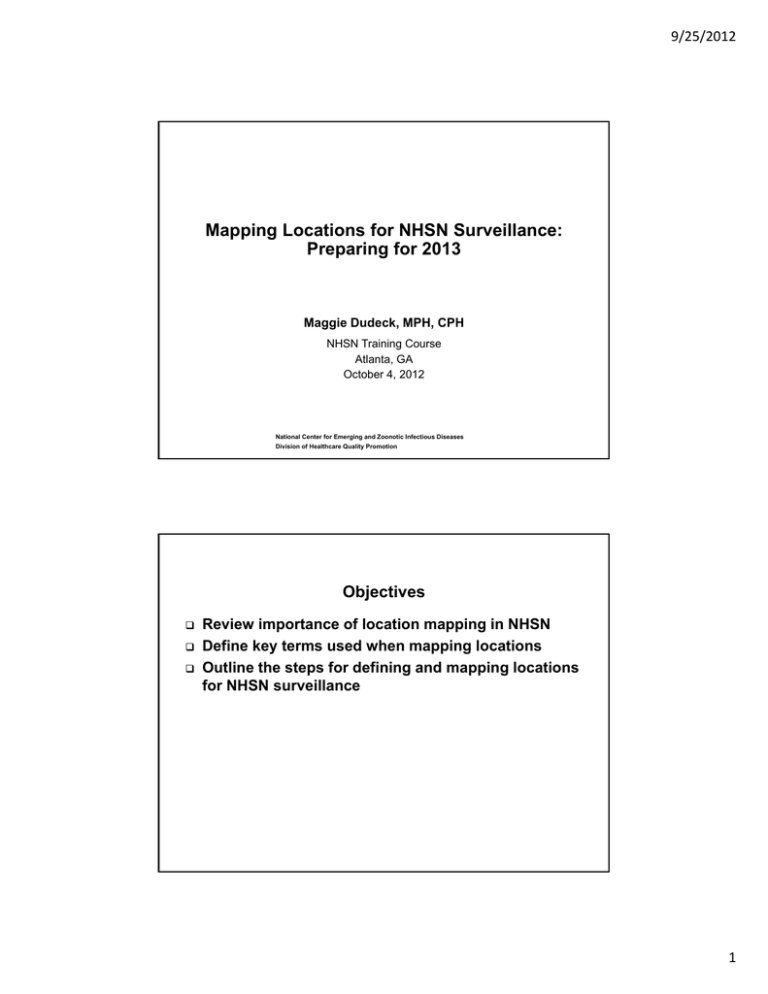
9/25/2012 Mapping Locations for NHSN Surveillance: Preparing for 2013 Maggie Dudeck, MPH, CPH NHSN Training Course Atlanta, GA October 4, 2012 National Center for Emerging and Zoonotic Infectious Diseases Division of Healthcare Quality Promotion Objectives Review importance of location mapping in NHSN Define key terms used when mapping locations Outline the steps for defining and mapping locations for NHSN surveillance 1 9/25/2012 Our Plan for this session… We will go through some straight-forward, as well as some more complex examples of location mapping We won’t discuss, as a group, some of the unique situations each of you may have If you have a unique situation in which the location mapping process cannot answer, please instead email us at nhsn@cdc.gov Documents The following documents will be discussed in this training: Defining Patient Care Locations in NHSN • Decision-making tool with decision tree • In your Resource Book CDC Location Labels and Location Descriptions • Provides definitions of each CDC location used for NHSN surveillance • http://www.cdc.gov/nhsn/PDFs/pscManual/15LocationsDescri ptions_current.pdf 2 9/25/2012 Importance of Correct Location Mapping NHSN location types are developed in order to identify “like populations” within different facilities. Like populations are believed to have similar risks for healthcare-associated infections (HAIs) Similar medical devices Similar invasive procedures Similar host factors affecting susceptibility Many NHSN surveillance modules utilize location type as a risk factor, e.g. CLABSI, CAUTI, VAP, MDRO/CDI, etc. Importance of Correct Location Mapping NHSN pooled mean rates of infection are calculated for location types and utilized in data analysis, such as the Standardized Infection Ratio. Incorrectly mapped locations affect the validity of: NHSN database data Facility-based standardized infection ratios State validations Bottom line: Without correctly mapped locations, facilities cannot compare their data to the NHSN data and NHSN data validity is compromised for identifying trends in HAIs. 3 9/25/2012 Why now??? Hospitals participating in CMS’s Hospital IQR program will be required to report MRSA bacteremia LabID events and C. difficile LabID events to NHSN beginning January 2013 This requires the mapping of every inpatient unit in your facility to a CDC-defined location for appropriate numerator reporting We recommend that facilities begin this process now, in preparation for reporting in 2013. NHSN Location Terms NHSN 80% Rule Virtual Locations Mixed Acuity Unit 4 9/25/2012 NHSN 80% Rule Each patient care area in a facility that is monitored in NHSN is “mapped” to one or more CDC locations The specific CDC location code is determined by the type of patients cared for in that area, over the last full year, according to this rule If ≥ 80% of patients are of a certain type, then that area is designated as that type of location NHSN 80% Rule Example: If ≥ 80% of patients in an area are pediatric patients with orthopedic problems, the area would be mapped as an “Inpatient Pediatric Orthopedic Ward” • 100% of the patients in this unit would be included for surveillance. 5 9/25/2012 Virtual Locations Created in NHSN when a facility is unable to meet the 80% Rule for location designation in a single physical unit, but would like to report their NHSN surveillance data for each of the major, specific patient types in that unit Virtual Locations Example: 5 West ICU: Approximately 50% neurology patients and 50% neurosurgery patients Rather than map as a medical/surgical critical care unit, the facility can create 2 locations in NHSN: • 5WEST_N: Neurologic Critical Care • 5WEST_NS: Neurosurgical Critical Care 6 9/25/2012 Virtual Locations Example cont.: Facility will collect and enter data for 5WEST_N and 5WEST_NS separately Facility will obtain rates and standardized infection ratios (SIRs) for each location separately Virtual Locations NOTE: The option of creating virtual locations may be easier for those physical units that are geographically split by patient service or those in which beds are designated by service For facilities using an electronic source for collecting data, the compatibility of virtual locations in NHSN should be discussed with the EHR contact prior to reporting data for these locations 7 9/25/2012 Mixed Acuity Unit Intended for units comprised of patients with varying levels of acuity, e.g., CC and Step down; CC and ward CDC does not have plans to publish national pooled mean rates for this location type If your facility chooses to use this location designation for reporting, you will not be able to compare your mixed acuity unit rates to an NHSN pooled mean, nor will these data be included in any SIR analyses Mixed Acuity Unit Implications on data reported for the CMS Hospital Inpatient Quality Reporting Program and/or state’s reporting mandate(s): Mixed Acuity Units are not included in any ICU-specific reporting requirements Contact your Quality Improvement Organization (QIO) for more information on how this location designation may impact compliance with CMS HAI reporting measures For state mandates, contact the state HAI coordinator http://www.cdc.gov/HAI/state-based/index.html 8 9/25/2012 Defining Patient Care Locations in NHSN STEPS FOR DEFINING A CDC LOCATION Steps for Defining Locations in NHSN Step 1: Define the acuity level for the location Step 2: Define the type of service for the location 9 9/25/2012 Step 1: Acuity Level Is this patient care area comprised of at least 80% of patients that are of the same acuity level?* Examples of acuity levels: • • • • Critical Care Units (CC) Inpatient Specialty Care Areas (SCA) Inpatient Wards Step Down Units If YES, proceed to Step 2 and map to a location type of that acuity level using the NHSN 80% Rule for that specific type * Based on patient mix over last full year Step 1: Acuity Level If NO: • Can this patient care area be split into 2 or more locations in NHSN for the purposes of surveillance, also referred to as “virtual locations”? o o If YES: Proceed to Step 2 and create locations in NHSN for each of the acuity levels, using the NHSN 80% Rule If NO: Map to a CDC Mixed Acuity location 10 9/25/2012 Decision Tree Step 1: Acuity Level Is this patient care area comprised of at least 80% of patients that are of the same acuity level? YES NO Proceed to Step 2 and map to a location type of that acuity level using the NHSN 80% Rule for that specific type Can this patient care area be split into 2 or more locations in NHSN for the purposes of surveillance – also referred to as “virtual locations”? YES NO Proceed to Step 2 and create locations in NHSN for each of the acuity levels, using the NHSN 80% Rule Map to a CDC Mixed Acuity location Step 2: Type of Service Is this patient care area a general medical, surgical, or medical/surgical unit? Or is it comprised of patients from a specific service type (e.g., burn, cardiac)? See NHSN Manual, Chapter 15 CDC Location Labels and Location Descriptions @ http://www.cdc.gov/nhsn/TOC_PSCManual.html 11 9/25/2012 Step 2: Type of Service If GENERAL: Are more than 60% of patients either medical or surgical? If YES: Create a location in NHSN that is mapped to the majority type (medical or surgical) If NO: Create a location in NHSN that is mapped to a combined medical/surgical CDC location • The mix of patients should then be a 50/50 to 60/40 mix of medical and surgical patients Decision Tree Step 2: Type of Service Is this patient care area a general medical, surgical, or medical/surgical unit? Or is it comprised of patients from a specific service type (e.g., burn, cardiac)? General Specific If general medical or surgical, are more than 60% of patients either medical or surgical? YES Create a location in NHSN that is mapped to the majority type (i.e., medical or surgical) NO The mix of patients should then be a 50/50 to 60/40 mix of medical and surgical patients Create a location in NHSN that is mapped to a combined medical/surgical CDC location If the unit is comprised of patients of a specific service type, does this unit meet the NHSN 80% Rule for locations? YES Create a location in NHSN that is mapped to that CDC location NO Can this single unit be split into 2 or more units in NHSN for the purposes of surveillance – also referred to as “virtual locations”? 12 9/25/2012 Step 2: Type of Service If SPECIFIC: Does this unit meet the NHSN 80% Rule for locations? If YES: Create a location in NHSN that is mapped to that location type If NO: Can this single unit be split into 2 or more units in NHSN for the purposes of surveillance, also referred to as “virtual locations”? Decision Tree Step 2: Type of Service Is this patient care area a general medical, surgical, or medical/surgical unit? Or is it comprised of patients from a specific service type (e.g., burn, cardiac)? General Specific If general medical or surgical, are more than 60% of patients either medical or surgical? YES Create a location in NHSN that is mapped to the majority type (i.e., medical or surgical) NO The mix of patients should then be a 50/50 to 60/40 mix of medical and surgical patients Create a location in NHSN that is mapped to a combined medical/surgical CDC location If the unit is comprised of patients of a specific service type, does this unit meet the NHSN 80% Rule for locations? YES Create a location in NHSN that is mapped to that CDC location NO Can this single unit be split into 2 or more units in NHSN for the purposes of surveillance – also referred to as “virtual locations”? (Continued) 13 9/25/2012 Step 2: Type of Service Can this single unit be split into 2 or more units in NHSN for the purposes of surveillance, also referred to as “virtual locations”? If YES: Create locations in NHSN for each of these specific service virtual locations If NO: Is the mix of patients in this unit approximately a 50/50 to 60/40 mix of combined medical and surgical? Step 2: Type of Service Is the mix of patients in this unit approximately a 50/50 to 60/40 mix of combined medical and surgical? • If YES: Create a location in NHSN that is mapped to a combined medical/surgical unit • If NO: Create a location in NHSN that is mapped to the location of the majority type (greater than 60%), either medical or surgical 14 9/25/2012 Decision Tree Step 2: Type of Service Can this single unit be split into 2 or more units in NHSN for the purposes of surveillance – also referred to as “virtual locations”? YES Create locations in NHSN for each of these specific service virtual locations NO Is the mix of patients in this unit approximately a 50/50 to 60/40 mix of combined medical and surgical? NO YES Create a location in NHSN that is mapped to a combined medical/surgical unit Create a location in NHSN that is mapped to the location of the majority type (i.e., greater than 60%) ‐ either medical or surgical Reassess location designations whenever there is a major change in patient types admitted to a location or new locations are added. Defining a Patient Care Location in NHSN EXAMPLES 15 9/25/2012 Example 1 An ICU that is 40% neurosurgical, 40% surgical, and 20% medical Example 1 An ICU that is 40% neurosurgical, 40% surgical, and 20% medical CDC location: Option 1: Single CDC location • Surgical Critical Care (IN:ACUTE:CC:S) Why? • Meets 80% Rule for critical care acuity level and does not meet the 80% Rule for a specific service level alone, but when surgical patients are combined, that total does equal 80% 16 9/25/2012 Example 1 An ICU that is 40% neurosurgical, 40% surgical, and 20% medical CDC location: Option 2: Multiple CDC Virtual locations • Neurosurgical Critical Care and Surgical Critical Care Why? • By splitting this unit into 2 virtual locations, each meets the 80% Rule for critical care acuity level and one meets the 80% Rule for designation as Neurosurgical Critical Care, while the other meets the 60% Rule as general surgical service (when combining surgical and medical patients) Example 2 A unit that is comprised of 60% medical ICU and 40% step down patients 17 9/25/2012 Example 2 A unit that is comprised of 60% medical ICU and 40% step down patients CDC location: Option 1: Single CDC Location • Mixed Acuity Unit Example 2 A unit that is comprised of 60% medical ICU and 40% step down patients Option 1: Mixed Acuity Unit Why? • This location is not comprised of at least 80% of patients of the same acuity level and therefore meets the single location definition of a mixed acuity unit NOTE: This location is not considered an ICU location type for the purposes of NHSN reporting and therefore would not be included in any ICU-specific reporting requirements 18 9/25/2012 Example 2 A unit that is comprised of 60% medical ICU and 40% step down patients CDC location: Option 2: Multiple CDC virtual locations • Medical Critical Care and Step-Down Unit Why? • By splitting this unit into 2 virtual locations, each meets the 80% Rule for the appropriate acuity level and each meets the 80% Rule for type of service Resources Defining Patient Care Locations in NHSN • Decision-making tool with decision tree • In your Resource Book CDC Location Labels and Location Descriptions • Provides definitions of each CDC location used for NHSN surveillance • http://www.cdc.gov/nhsn/PDFs/pscManual/15LocationsDescri ptions_current.pdf 19 9/25/2012 Help with Mapping If you’re having trouble mapping a unit in your facility to a CDC location using the 2-step “decision tree”: Email nhsn@cdc.gov Include location bedsize and details of the patient mix (e.g., acuity level, % of patients in each service) Thank you! 20



